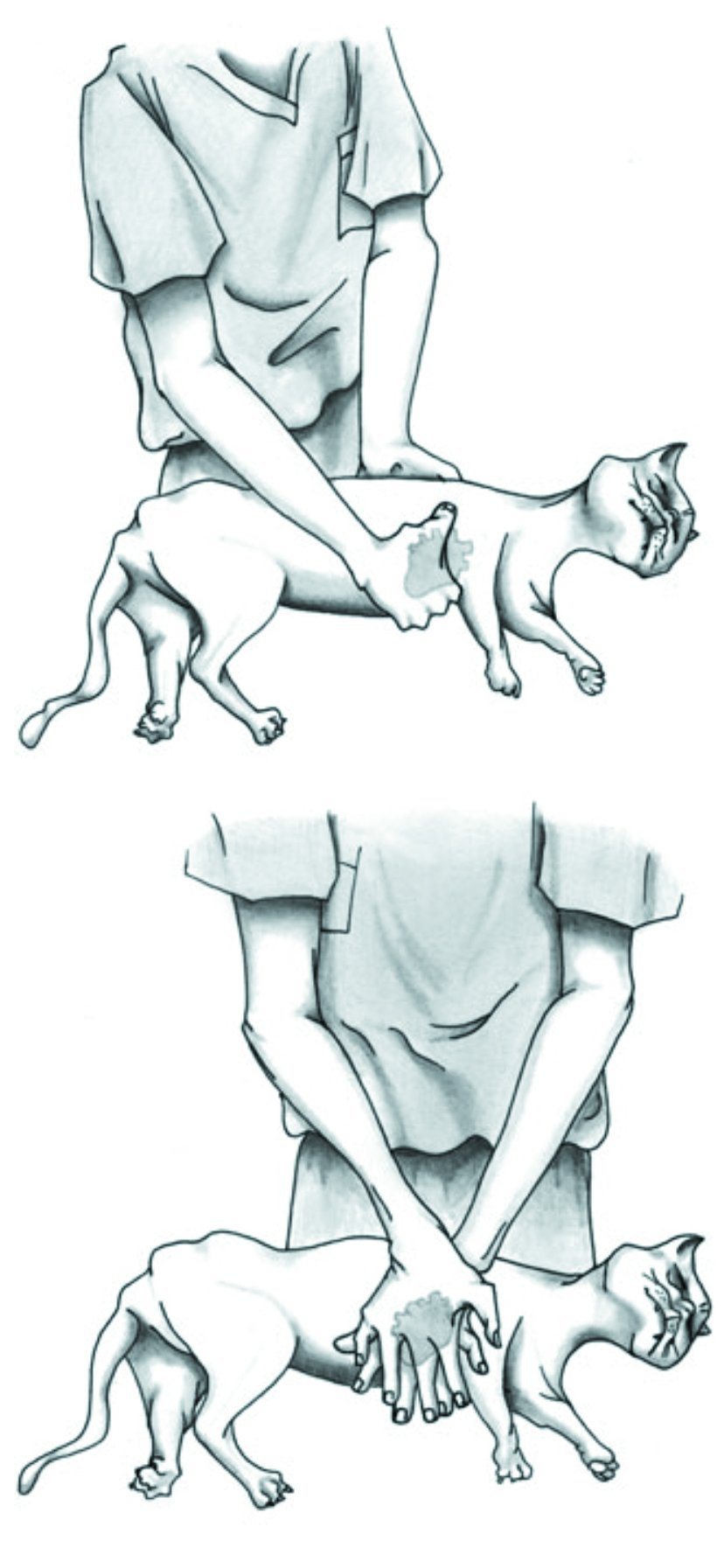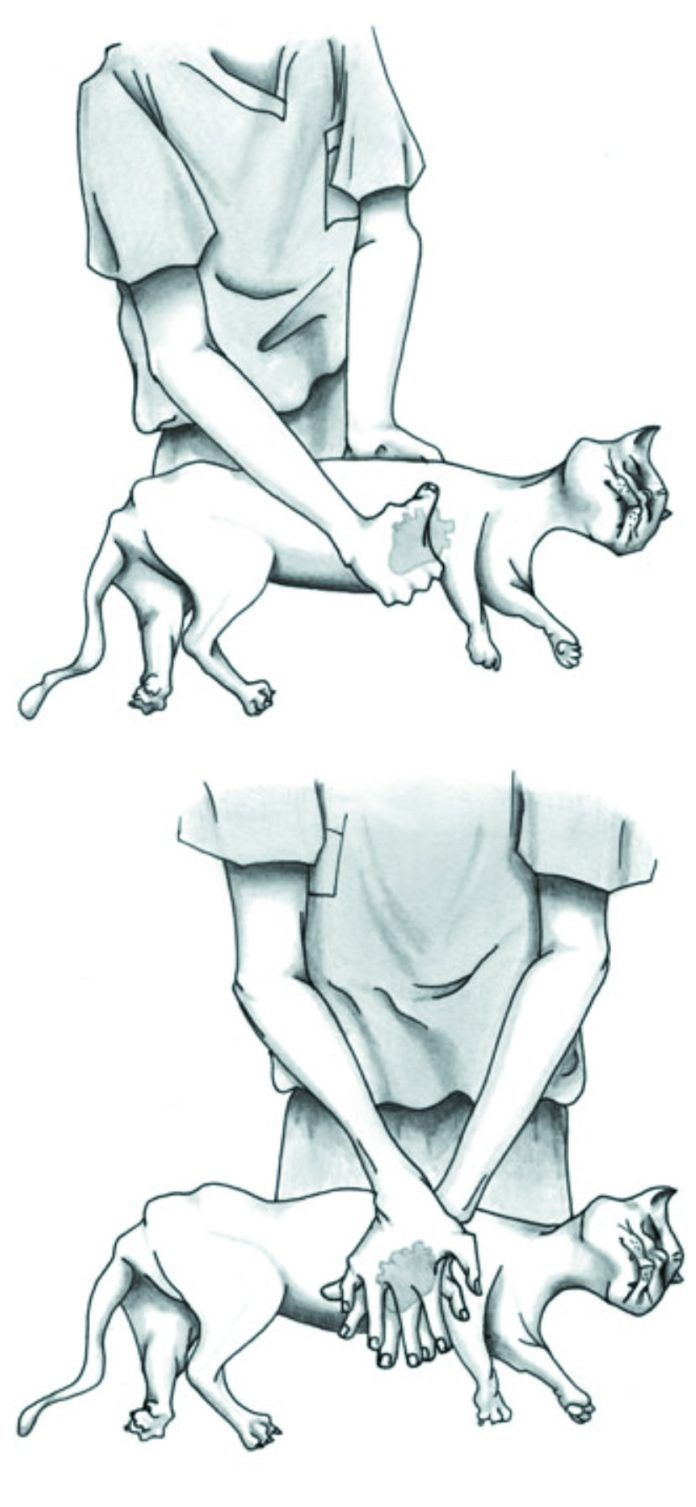Even the most caring cat owner probably wouldn’t list mouth-to-snout as the preferred way of expressing affection. But what if it could save the life of a companion animal who has stopped breathing?
Not long ago two cats were pulled from a burning apartment building in Queens, New York. They were unresponsive when firefighters began performing CPR (cardiopulmonary resuscitation) to see if they could get the pets to start breathing again. The cats’ owner watched nervously, until telltale meows finally let her know everything was going to be okay.
Easy, right? Well, not really. When you search the internet for the correct way to perform CPR on a feline, different well-meaning organizations offer different instructions. For instance, one says to give a breath for every 10 chest compressions. Another says to give two breaths. Still another says to start with breaths, then give chest compressions, while a different site reverses the recommended order. What’s right?
The best CPR instructions
RECOVER, which stands for the Reassessment Campaign on Veterinary Resuscitation, is a set of guidelines for giving CPR to cats (and dogs) based on evidence drawn from the scientific literature. RECOVER was developed by a group of emergency and critical care specialists from multiple veterinary schools across the globe, including Tufts.
According to the Journal of Veterinary Emergency and Critical Care, which published the RECOVER guidelines, no comparable evidence-based guidelines for conducting CPR were previously available. “The absence of standardized, comprehensive training coupled with a lack of consensus…has led to significant variability in the approach to veterinary CPR, likely to the detriment of our patients,” the study authors said. To close the gap, they scoured the available literature to arrive at a consensus on which CPR technique works best.
See page 4 for a synopsis of the guidelines. Bear in mind that many cats faint or lose consciousness for 10 to 20 seconds or so for reasons having nothing to do with cardiac arrest requiring CPR. Cats in the majority of these cases will get up on their own. Also important to keep in mind is that sometimes an owner gets bitten or scratched in the process. If you start mouth-to-snout CPR, make certain the cat actually needs it: she should be non-responsive for more than 15 seconds with no heartbeat and no respiration.
Finally, be aware that the success rate of CPR is low. When CPR is performed on cats right in the hospital, some 35 to 45 percent will start breathing again. Numbers don’t exist for CPR performed outside the hospital, but it is reasonable to assume that the odds for “coming to” are much lower.
That doesn’t mean you shouldn’t have CPR in your toolbox as your cat’s primary healthcare provider. You just want to manage your expectations.

4 Steps for CPR
➤ Step 1. Cat position and hand placement. It’s not like CPR for people, with the cat on her back and the base of your two palms pushing down on her chest. Instead, the cat should be on her side. And for most cats, not two hands but one — wide enough to pretty much wrap around the cat’s chest — will work. You place your fingers around the sternum (breastbone) at the level of the heart. (Larger cats that are more like the size of small dogs may need two hands. See the second illustration.)
➤ Step 2. The compressions. This is probably the trickiest part of CPR. The evidence is strong that the odds of a cat’s coming to and surviving 24 hours later are stronger if the compression rate is 100 to 120 pushes a minute. How fast is 100 compressions a minute? One anecdotal recommendation is to sing “Stayin’ Alive” and go with the rhythm of the song.
The compressions themselves should be pretty deep, with the hand pressing the chest down more or less to a depth that equals one third to one half the width of the thorax (essentially the chest cavity). The chest should come fully back up between compressions; you should not push down again until there has been what scientists call “full elastic re-coil.” Otherwise, you’re not sending blood through the circulatory system as completely as possible, so the cat has less chance of regaining consciousness.
➤ Step 3. Ventilation (Mouth-to-Snout). Hold the cat’s mouth closed tightly and place yours over the animal’s nostrils to make a seal with the snout, then blow into the nostrils. Start with 30 compressions followed by two breaths. Lose as little time as possible between the breaths and the next set of compressions.
➤ Step 4. Get the cat to the hospital. If the cat does not respond after about five two-minute cycles, the odds are very low that she will. Conscious or not, get her to the emergency room immediately. A veterinary facility has machinery and medications that will facilitate treatment, giving her a better chance of long-term survival.





What a fabulous article on CPR for felines!! Never know when one might need it!!!
Boy, you really don’t want to practice this unless you are SURE your cat is unconscious! Just thinking about the mouth-to-snout…